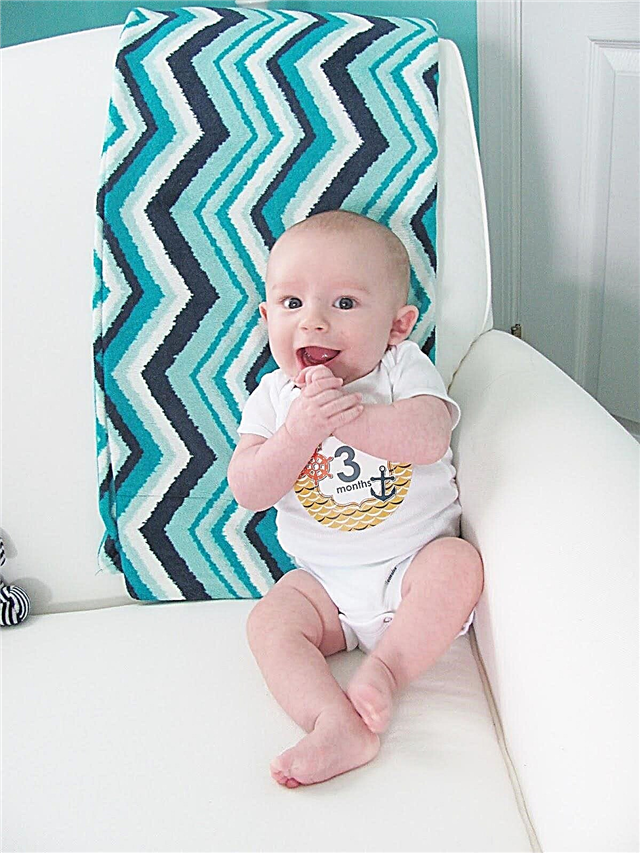One of the first tasks of a mom or dad when playing on the playground is to ensure the safety of their baby. Despite the "thoughtfulness" of modern attractions, even the simplest of them can pose a threat to the health of the crumbs. And more often not because of the danger or malfunction of the structures, but due to an oversight of the parents. What exactly is a danger to the health of the child in the playground? How to avoid this? What principles should be followed when controlling a child on a walk?

Playground: risk factors and proper behavior
It is very important not only to monitor the playing kid, but also to regularly teach him safety rules. The younger the child, the more difficult it is for him to keep something else in consciousness besides the emotions caused by the game. Usually children under 5 - 6.5 years old are not able to control the situation, they go headlong into the process and lose the instinct of self-preservation. If parents do not insure at the right time, trouble is inevitable.
Dangerous play installations
- Trampoline.
It can be conditionally safe only with a protective mesh. In any case, there is a high probability of injury from the accidental impact of children jumping around. It is important not to allow babies under 2 - 3 years old or children suffering from heart, vascular or nervous system diseases on the trampoline. Explain to the baby that in no case should you land on the trampoline upside down, push other children, climb onto the sides of the trampoline. In the absence of a protective net, the risk of the baby falling to the ground right in the jump is extremely high. Alas, there are quite a few such cases.
- Slide.
It is considered more or less safe if there are guardrails. Usually, children do not follow the sequence in skating, shove and push each other, climb under the arms, try to overtake each other, which is fraught with blows, falls and serious injuries. Take the initiative: as an adult, offer to ride in turns, gently besiege especially active ones, do not allow pushing. It is not uncommon for a child to fall off the upper platform, which is not properly equipped with handrails, or right while sliding down the hill itself - due to the movement of another child.
- Ladder, Swedish wall, horizontal bar.
Do not leave the child when he is near such simulators, especially during the first workouts. It is necessary to stand nearby and insure the baby - at any moment the child's leg or handle may slip off the bar or not find support.
- Carousel.
Teach your toddler to hold on tightly, avoid sudden movements, especially jumping off or on the attraction. Parents' insurance is, of course, required.
- Swing.
An ordinary swing installed in every yard can cause very serious injuries to a child (from minor bruises to concussion). Children often invent extreme ways of rolling - standing, sitting with their backs, doing the so-called "sun", jumping to the ground in the process, running past the swinging swing.
Swings in the form of animal silhouettes pose an increased risk: as a rule, they do not differ in strength and high quality of installation. The child can either fall out of them or fall along with the structure itself.
- Sports construction with ropes.
The main danger is that the baby is capable of inability to get entangled in the ropes or unsuccessfully to tighten some part of the body in the loop. Although, under the careful supervision of parents, this is an excellent attribute for the physical development of the child.
- Gymnastic rings.
The simulator requires a certain amount of physical training, therefore, first, organize the support and insurance of adults for the baby, otherwise injuries cannot be avoided.
Other hazards

- Sandbox.
It is worth carefully examining the territory of the sandbox before letting the child play in it. Often this play area becomes a haven for homeless people, drug addicts or companies drinking alcohol. The sand can contain used syringes, cigarette butts, broken glass fragments, animal excrement. Parents' carelessness can lead to sad consequences: cuts, child poisoning and even blood poisoning.
- Animals - dogs and cats.
Animals are great, but stray dogs and cats carry many dangerous diseases and can often be aggressive. A dog bite leaves a deep psychological trauma in a small child, makes it necessary to receive rabies injections, which is also difficult for a baby. To avoid such situations, carry a gas canister or a shocker with you for a walk, which can scare off an attacking animal.
- The surrounding flora and fauna - plants, mushrooms, berries, bees, wasps, bumblebees.
Young children do not realize that sand and grass are inedible. They can easily pick up an abandoned candy from the ground, pick a poisonous berry or mushroom and eat them. They can, attracted by the bright and colorful appearance of a bee or a ladybug, grab them in their hands and also send them into their mouths. For a kid with his minimal life experience, there are still no ideas of "dangerous", "poisonous", "bites". He focuses on the attractiveness of surrounding objects and phenomena, tries everything to the teeth. It is important not only to explain how not to act, but also to constantly monitor the child.
If your baby is susceptible to allergic reactions to any plants or insect bites, especially carefully monitor his game. Remember that neglect of this issue can end very sadly for your baby.
- Surrounding children.
Not everyone brings up their children in the same way. A cute baby with an angelic gaze can turn out to be an uncontrollable little bandit who strives to cover other children with sand or substitute a footboard. It's good if the naughty mom is within reach. It is even better if it is adequate. But this is not always the case, so the responsible mission for maintaining the safety of the child rests on your shoulders.
- Adults.
We all watch TV and read the news, and therefore we know that the adults around us can hide the greatest danger. Who knows what lies behind the kindest appearance of that cute uncle who treats the kids with sweets? Parents of children who went missing, killed by maniacs or pedophiles, also did not think that such a horrible fate would affect their boy or girl. Be careful and teach your baby the same.
How to teach your child about safety

The main principle of safe walking with a child under 7 years old is that you must not leave him unattended. The development of each child is individual, and only you can decide whether a son or daughter is ready for independent games: some children are very collected and attentive at the age of 5, while others have not yet learned to control themselves in the process of playing by the age of 8.
God protects the cherished one, as they say among the people, but it is impossible to foresee all the risks, no matter what kind of loving mother or father you are. Sometimes a split second is enough for a child to fall off a bike or fall off a swing. The only way out is to teach safety techniques together with your child. And not just hammer simple truths into the child's head, but explain, explain, give examples and analogies.
It is not necessary to scold the kid in advance for misdemeanors not yet committed by him, do not threaten or intimidate with danger. An important point: the right motivation is the key to success.
Turn the learning process into a game - for example, become a child on the playground, and he will be in the role of mom or dad teaching you about safety. You can invent and play at home with the help of toys those situations that you can get into while walking - riding a swing, attacking a dog, an adult's attempt to take a child away from the playground.
Playground safety rules: learning with your child
[sc name = ”rsa”]
- Before starting any game on the playground, do not be lazy to inspect it to assess safety: are the rides and simulators safe and sound, are there any poisonous plants, animals, holes, dirt and debris on the territory, is the sandbox clean.
- If possible, choose a play area with sand or special rubber coating. It is softer to fall on it than on the ground or asphalt.
- Choose shoes for your child with closed toes and a heel that sit firmly on the leg. The other easily falls off and it is easy to damage the foot when falling.
- Clothes should be comfortable and loose so as not to hinder the active movement of the baby. Eliminate wardrobe items that can catch on structures, tree branches and other items - ties, scarves, laces, flying ribbons, long lace frills, etc.
- Before walking, check that the child does not have gum in his mouth, but on the body or in the pockets of sharp objects (earrings, bracelets, watches).
- Giving preference to one or another play structure, commensurate the child's desires with his age.
- Play near swings and other equipment used by another child is not allowed.
- Do not allow the ball to be played outside of the designated areas. Especially close to transport routes.
- Teach your kid by example to jump correctly - from a slide, swing, wall and other high surfaces. The jump should be carried out on bent legs and on both limbs at once. Practice correct jumps with your child.
- You cannot climb the hill in a crowd. You should slide off it only after the previous child has rolled and walked away from the sliding path: only with feet forward and without leaning over the fences.
- Make sure there are no other children nearby when the child begins to swing, slide down a slide, or pedal a bicycle.
- In the event of an attack by a dog, do not panic, run or look the dog in the eyes. Use a stun gun or gas spray as soon as possible. If you don't have one or the other, get a regular spray deodorant.
- Discuss with your child in a confidential tone how to behave in certain situations: riding a swing, cycling, sliding down a hill, meeting an aggressive animal. Explain to the baby especially carefully that you should not trust unfamiliar adults (you cannot talk, take anything, leave with them).
- Do not move away from the baby if he climbs high - he can look down, but be afraid of heights and let go of his hands. If you do not have time to run up, the child will fall down on his back, and from the horizontal bar - upside down.
- Be sure to check that the gates (football, hockey, handball), rainbow ladders, horizontal bars (like swings) are well fixed and firmly dug into the ground.
- Discuss with your child what to do if a stranger speaks to him (do not take anything, do not go anywhere with him, do not talk).
If you want the information received to really be fixed in the child's brain, you need to constantly refresh it, repeating it before each walk and teaching you to apply the learned rules in practice. An essential nuance - you need not just tell the baby what you shouldn't do, but also explain what the danger is, what the result will be and how to do the right thing.
Swing

- If the swing is very heavy (for example, iron), you cannot jump off on the fly, you may not have time to run away, and then the swing will hit you right in the head or in the back.
- If you like to swing the swing yourself, you must always remember: if you push them harder and don't catch them, the swing will hit you right in the face.
- Don't run next to the swing! It may happen that the other child does not have time to brake, and you both get injured.
- Plastic rope swings are also unsafe. If you swing strongly on them, then leaning forward, you can easily turn the seat with your weight.
- In winter, hold onto the handrails of the swing especially tightly. You must have mittens or gloves on your hands - they will protect your hands from freezing to the iron handrails.
Carousel

- You cannot get off the carousel while it is spinning, as the next seat continues to move and can hit you hard if you do not run away.
- You cannot run in a circle, holding one seat, and spin an empty carousel, and then suddenly stop abruptly - you can get hit by the next seat.
- Do not stand on the carousel seat with your feet, as you can lose your balance while moving and, falling, hit your forehead.
Slides

- Carefully touch the slide, try it by touch: in the heat, the iron slides get very hot and you can get burned by touching the metal parts. And in winter you can freeze to them. Be careful (na)!
- Try to get away from the slide right after going down. Otherwise, everyone who follows you from above will fall on you.
- In some courtyards there are wooden slides. In the summer, inspect it carefully, whether there are any chips or cracks on it, otherwise, going down it, you risk getting a splinter.
- In winter, it is better to slide down the hill on special ice floes.
Outdoor games
During the cold season:
- Dress your child so that he does not sweat, but also does not freeze.
- It is better to choose clothes that are waterproof and comfortable, in which it is easy to engage in active games. Shoes should be on a firm sole that does not slip.
- Make sure that your child does not drag snow and icicles into his mouth.
- Insure your baby when riding down slides, ice skating and sledging.
- Avoid sitting on swings and other cold surfaces. You can carry a small pad for this.
- Take your toddler (and teach to do it yourself) from the slide after he has rolled to make room for the children who are rolling behind.
During the warm season:
- Be sure to protect your baby's head from the sun with a panama hat, cap or other headgear.
- Choose morning or evening time for a walk. It is harmful to stay in extreme heat for a long time.
- Check the temperature of the metal surfaces of slides and other structures. From the heat, they can heat up so that the baby gets burned.
- Check the sandbox for dangerous items before playing.
- Make sure that the baby does not pull anything into his mouth.
- Do not allow gum to be eaten or chewed while playing.
Remember that teaching your baby safety while walking is one of the most important tasks for moms and dads. But until a certain age, the child's only insurance is you.
- 6 ways to get your child out of the playground without hysteria
- Playground conflicts: how not to get into a fight?
***



